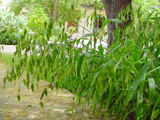Native Plants

Q. Who is Mr. Smarty Plants?
A: There are those who suspect Wildflower Center volunteers are the culpable and capable culprits. Yet, others think staff members play some, albeit small, role. You can torture us with your plant questions, but we will never reveal the Green Guru's secret identity.
Did you know you can access the Native Plant Information Network with your web-enabled smartphone?
Ask Mr. Smarty Plants is a free service provided by the staff and volunteers at the Lady Bird Johnson Wildflower Center.

rate this answer
Sunday - October 18, 2009
From: Greenville, SC
Region: Southeast
Topic: Grasses or Grass-like
Title: Indiangrass by seed or plugs in Greenville SC
Answered by: Barbara Medford
QUESTION:
Mr Smarty Plants, is it better to establish Indiangrass by plugs or seed? Seems you would get much quicker coverage by seed, tending to choke out "strangers". I'm establishing a small native meadow on my property, and Indiangrass is our state native grass. Could you suggest other grasses to plant concurrently that might provide better wildlife habitat (birds, butterflies,) and more colorful "flower"?ANSWER:
From our Native Plant Database, here are the Propagation Instructions for Sorghastrum nutans (Indiangrass):
Propagation Material: Seeds
Description: Propagate by sowing unstratified seed in fall or stratified seed in spring. Sow 1/4 deep. Division of older plants is difficult because of a dense, tangled root system.
Seed Collection: Collect seed in fall.
Seed Treatment: Seeds require dry stratification.
Commercially Avail: yes
Maintenance: Indian grass tolerates imperfectly drained soil. It is a good accent plant, however it needs tall companions to remain upright.
You will notice it says division of older plants is difficult, which means getting sod plugs would also be difficult. You are probably right that you would get quicker coverage by seed, but "choking out" strangers is not one of the benefits. No matter how carefully you clean and prepare your ground for seed, there are going to be other grass seeds also waiting for their chance to sprout. They will likely be natives to your area in northwestern South California, as is the Indiangrass. They will be just as acclimated to the climate, soil and rainfall of your area as the seed you purchased, and have been brought there by wind, animals and birds. All the grasses tend to look very similar when they first emerge. Never mind trying to find a spray that will kill everything but the Indiangrass. There are three kinds of herbicide sprays: wide spectrum, which will kill everything green it lands on; broad-leaf plant (or dicot) herbicide which won't kill the Indiangrass, but won't kill the other grasses either, and monocot herbicide which will kill the other grasses and the Indiangrass. Pulling out the grasses you don't want, or even mowing them very low, if you can do that without damaging the grasses you want, will keep the unwanted plants from seeding. But mostly they have to be pulled, again, before they go to seed. Slowly, the grass you want will cover the area sufficiently, but it's going to take a while.
On the subject of establishing a native meadow, which we think is a wonderful idea, read our How-To Articles Meadow Gardening, Butterfly Gardening and Wildlife Gardening. If you want some more grasses for your garden, go to our Native Plant Database, and using "Combination Search," select South Carolina (state, of course) and "grasses /grasslike" under General Appearance. When we tried this, we got 279 suggestions for native grasses. You can narrow this down by also selecting on Light Requirements and Soil Moisture. If you decide you want to add some wildflowers to your meadow, go to Recommended Species, select South Carolina on the map, and "herb" (herbaceous blooming plant) under General Appearance. We got 40 possibilities; again, this list can be refined by choosing Light Requirements, Soil Moisture, Duration, etc. We are going to suggest four of each just to get your started. Follow each link to the page on that individual plant to find out expected size, propagation methods, benefits, and so forth.
Grasses for a meadow in South Carolina:
Bothriochloa laguroides ssp. torreyana (silver beardgrass)
Chasmanthium latifolium (Inland sea oats)
Elymus villosus (hairy wildrye)
Muhlenbergia capillaris (hairawn muhly)
Herbaceous blooming plants for a meadow in South Carolina:
Asclepias tuberosa (butterfly milkweed)
Conoclinium coelestinum (blue mistflower)
Coreopsis lanceolata (lanceleaf tickseed)
Echinacea purpurea (eastern purple coneflower)
From our Native Plant Image Gallery:
More Grasses or Grass-like Questions
Will blue eyed grass grow under black walnut trees?
January 18, 2016 - Will blue eyed grass grow under black walnut trees? I know the Siberian Iris is tolerant but the scientific names are not the same yet everything I read indicates that blue eyed grass is not in the g...
view the full question and answer
Overseeding sprig planting of native grass in Kansas
September 12, 2009 - Can I overseed a Sprig planting of native grass in Kansas in the Fall?
view the full question and answer
What plants grow well in Athens, TX?
January 18, 2011 - Athens, Texas, we have very sandy soil mixed with clay, what plants grow well here?
view the full question and answer
Planting Habiturf in Houston, TX>
March 08, 2012 - First, I want to say thank you for such an informative site.
You say that the Buffalograsses tend to do well in drier and well drained soil. My house has a lawn that drops about 10 inches in about...
view the full question and answer
Need information about grasses for cattle grazing in Weatherford, TX.
September 16, 2012 - Need info on what I can plant for cattle to graze thru winter. grasshoppers and drought have decimated
our coastal hay for past 2 yrs.Is there anything we can treat all the weeds with besides chemic...
view the full question and answer
| Support the Wildflower Center by Donating Online or Becoming a Member today. |

